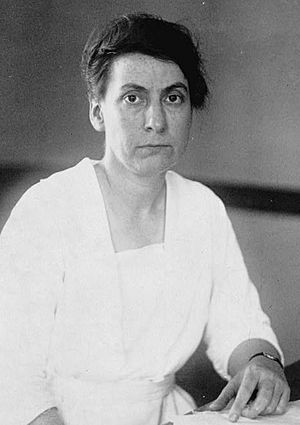Grace Abbott facts for kids
Quick facts for kids
Grace Abbott
|
|
|---|---|

Grace Abbott in 1929
|
|
| Born | November 17, 1878 |
| Died | June 19, 1939 (aged 60) |
| Occupation | Social worker |
| Parent(s) | Othman A. Abbott and Elizabeth M. (Griffin) |
Grace Abbott (born November 17, 1878 – died June 19, 1939) was an important American social worker. She worked hard to improve the lives of immigrants and to protect children. She was especially known for fighting against child labor, which meant making sure children didn't work in dangerous jobs or for too many hours. Her older sister, Edith Abbott, was also a social worker, and they often worked on similar goals.
Contents
Grace Abbott's Early Life and Education
Grace Abbott was born in Grand Island, Nebraska. Her parents were O. A. Abbott and Elizabeth M. Griffin. She finished college at Grand Island College in 1898. Before she became a social worker, she taught high school in her hometown until 1906. In 1903, she began studying at the University of Nebraska–Lincoln.
Moving to Chicago and Helping Immigrants
In 1907, Grace Abbott moved to Chicago and started her career in social work. She lived at the Hull House, which was a special place in the city. It was a center for women who wanted to make society better and a safe place for people who were poor.
In 1909, Abbott earned a special degree called a Ph.M. in political science from the University of Chicago. From 1909 to 1910, she wrote weekly articles for the Chicago Evening Post. These articles were called Within the City's Gates. They showed how immigrants were being treated unfairly.
Working for Child Welfare and Labor Rights
Grace Abbott was part of many groups and committees that worked to help children.
- From 1908 to 1917, she worked with the Immigrants' Protective League.
- From 1921 to 1934, she was part of the Child Labor Division of the United States Children's Bureau.
- She was also a member of the Women's Trade Union League.
In 1911, she helped start the Joint Committee for Vocational Training. She worked with Sophonisba Breckinridge and her sister, Edith Abbott, on this committee.
Leading the Child Labor Division
From 1917 to 1919, Grace Abbott was the director of the child labor division for the U.S. Children's Bureau. In this role, she was in charge of carrying out a law called the Keating–Owen Act (1916). This law aimed to stop child labor. However, the Supreme Court of the United States later overturned this law in 1918.
Even after the law was overturned, Abbott found ways to keep parts of it going. She added special rules into contracts between the government and private companies that made war goods. These rules helped protect children from working in factories.
Fighting for a Child Labor Amendment
In 1924, Grace Abbott worked very hard to pass a new change to the country's main laws, called a constitutional amendment. This amendment would have made child labor illegal everywhere. However, it was never approved by enough states.
Abbott also wrote several important books about society. These included The Immigrant and the Community (1917) and The Child and the State (1938). She was also important for using facts and research about society to help create new laws. She investigated places like shipbuilding plants and factories across the United States to find child labor violations.
Influencing Government and Social Security
Grace Abbott was a pioneer in using information about child labor, young people who broke laws, and families needing help to create new laws. She spent a lot of time in Washington, D.C., trying to convince lawmakers to support social issues.
From 1934 until she passed away in 1939, she was connected with the Social Security Administration. During this time, Abbott helped write the Social Security Act. This important law created a system to help people with money, especially older people. She also led several government committees focused on child welfare and other social issues.
Grace Abbott was the first woman ever suggested for a position in the President's cabinet, but she was not approved for the job. Her mother was a Quaker who later became a Unitarian. Her father, Othman A. Abbott, was the first Lieutenant Governor of Nebraska. Grace Abbott never married. She was a professor at the University of Chicago from 1934 until 1939, teaching about public welfare.
Later Life and Legacy
In 1938, doctors found out that Grace Abbott had a serious illness called multiple myeloma, which is a type of cancer. She passed away one year later because of this disease. At the time, cancer was a very feared illness. Because of this, she and her sister kept her diagnosis a secret. Her obituary in The New York Times said she died from "anemia" instead.
Grace Abbott is a member of the Nebraska Hall of Fame. The School of Social Work at the University of Nebraska at Omaha is named in her honor, celebrating her important work.
See also
 In Spanish: Grace Abbott para niños
In Spanish: Grace Abbott para niños

